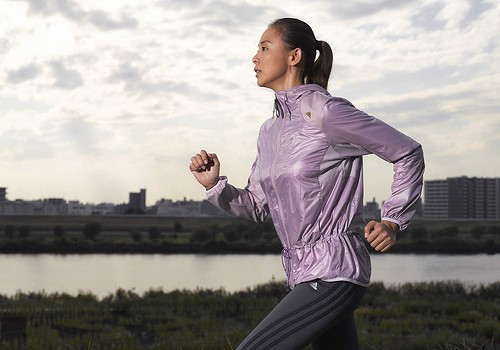
Dress properly
There is no reason why you cannot carry on enjoying running when the winter draws in but its important to keep warm while out in the cold air. To start with wearing shorts is probably not the best idea, so invest in a good pair of leggings. They are not just for women and you will find they are more beneficial due to less friction when running and stimulating blood flow. Secondly, a base layer upper garment will make sure you are kept warm and needs to be tight fitting. Lastly, you must wear bright, reflective or fluorescent outer clothing to make sure you can be seen by other road users.
- Important notification about information and brand names used in this slideshow!
- Photo courtesy of adifansnet by Flickr : www.flickr.com/photos/adifans/3407390932
- www.wikihow.com/Jog-in-Cold-Weather
- http://www.wikihow.com/Keep-Running-During-Snow-Season
- http://running.about.com/od/coldweatherrunning/tp/8-Steps-To-Enjoying-Cold-Weather-Running.htm
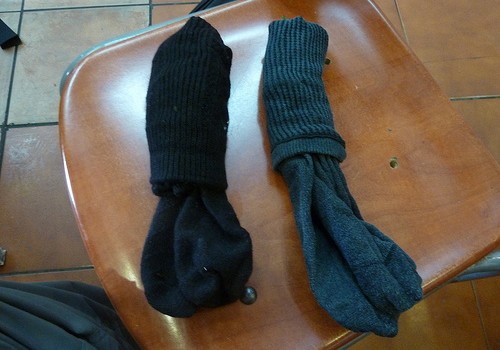
Wear an extra pair of socks
Keeping your feet warm when running is essential because with lightweight running trainers more common they provide little warmth. You want to avoid wearing just one pair which is big and bulky as layering up is a much better option when looking at the feet. The inner sock should be a thin traditional running sock which absorbs sweat and avoids friction. Then the outer sock should be slightly thicker with a woolly or fleece lining for warmth. Traditionally people associated blisters with incorrect socks so layering up will stop the risk of shoes slipping from wearing the wrong type of sock purely for warmth.
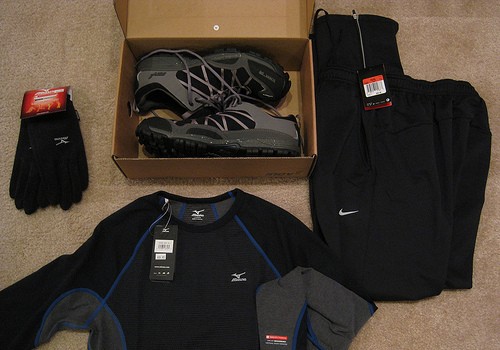
Pick the right footwear
Particularly in winter there is a high risk of ice or snow on the path's which you run so the appropriate footwear will avoid falls and injuries. Running trainers come in many shapes and styles but a winter shoe should be a solid more firm fitting shoe with added traction. The added traction and grip on the surface of the shoe allows more grip on slippery surfaces, trail running shoes are often good for winter running as they are designed to cope with differing terrains. It is worth spending a decent amount of money on running shoes and not buying the cheapest as they can make the difference between running and falling!
- Important notification about information and brand names used in this slideshow!
- Photo courtesy of Phillip Stewart by Flickr : www.flickr.com/photos/phillipstewart/5167948257/
- www.wikihow.com/Jog-in-Cold-Weather
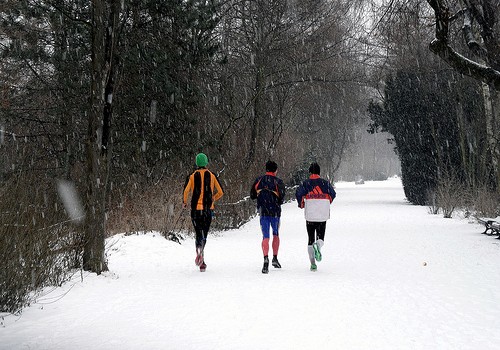
Walk a little before you start jogging
Getting your body used to the cold temperature is important so the body does not go into a state of shock as you walk outside, making it harder for the blood to travel around. Rather than going straight into a jog, have a quick walk for the first 5 minutes varying the intensity. This has two main benefits, it works as part of the warm up to increase the heart rate and get blood to the muscles. But it will also allow you to adapt to the terrain, check you are warm enough and that you are wearing the right footwear for the conditions.
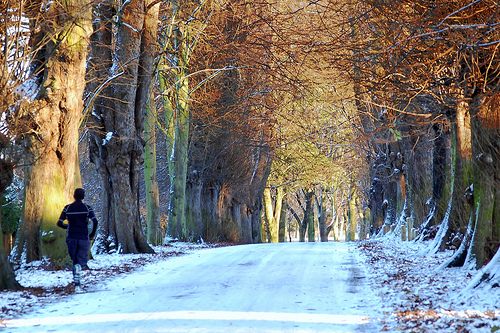
Run on familiar trail
The biggest challenge about running in the winter is the darkness at an earlier hour. Most people run in the evenings after work to de stress and recover from a bad day. No with the winter days being shorter it is completely dark by 5pm. Therefore fluorescent clothing is essential but also run a trail or area that you know well. This will make sure you don't get lost and that people know where you have ran. Also knowing the trail means there will be no surprises such as sudden turns, dead ends or problems with the terrain being unstable and unfamiliar.
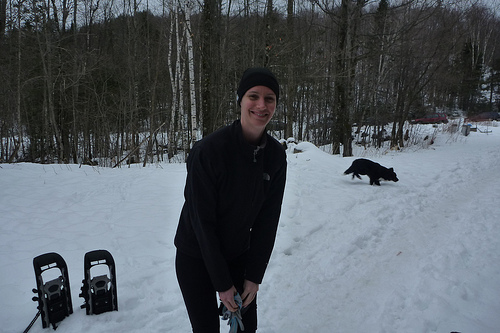
Warm up
A warm up is important in any sport or exercise session but when running in very cold outdoor temperatures it is even more important. When the temperature outside the body is significantly low it takes longer for the blood to move to the extremities as it wants to stay in your core, hence the reason for cold toes and fingers. Perform a brief warm up in doors to get the heart rate up and the blood into your muscles, and then spend some time completing some dynamic stretches such as high knees or heel kicks to get the muscles ready for action.

Post-workout relaxation
When you return from a cold run you need to warm yourself back up as well as cool down. Make sure to take off any sweaty clothes as when you cool down the wet layers will make you extremely cold. A good way to warm up and recover is have a hot shower or bath, but not too hot. This will aid in muscle recovery as well as make you feel nice and cosy. Its important to have a nice meal when you return from a winter run, a hearty soup will warm you up nicely and refuel you.
- Important notification about information and brand names used in this slideshow!
- Photo courtesy of Ginny by Flickr : www.flickr.com/photos/ginnerobot/4270845019/
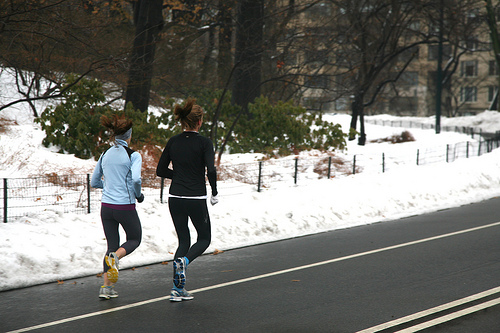
Ask someone to start jogging with you
Running alone in the dark can be dangerous. If you become injured or fall over in the dark people may not be able to see you so having a running buddy will help keep you safe. Also, running in numbers is a much safer way as cars and other road users are more likely to notice a group of runners instead of just the odd one. Running in pairs also deters thieves or other people who mean you harm, And someone always knows where you are and family and friends are a lot less likely to worry about you.
- Important notification about information and brand names used in this slideshow!
- Photo courtesy of (vincent desjardins) by Flickr : www.flickr.com/photos/endymion120/5484232220/
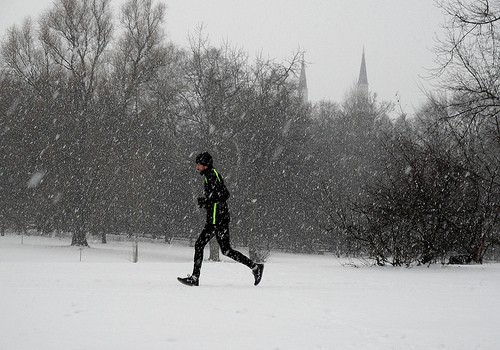
Beware of wind and don't overdo
The wind can pose a risk when running. During the autumn and periods of winter gusting winds are quite common. make sure to check the weather forecast and be careful not to get caught running against the wind. Sometimes this can be a great training effect but make sure you are prepared for the difficult conditions this produces. Do not run directly into the wind if you are a beginner as this will effect your form and cause injury, also be careful as this can make you push yourself too hard without meaning to leading to fatigue.
- Important notification about information and brand names used in this slideshow!
- Photo courtesy of onnola by Flickr : www.flickr.com/photos/30845644@N04/8520947678/
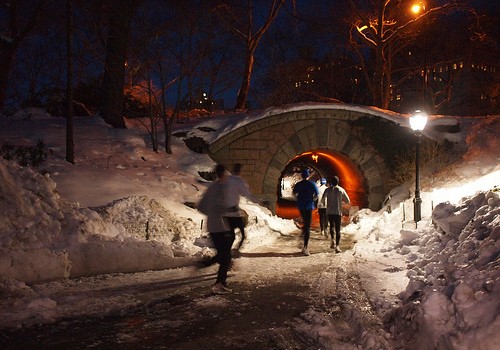
Beware of ice
The hardest thing about ice is you cant always see it particularly at night. Make sure you run in areas that are less likely to have surface ice, for example running on paths that are untreated or salted will increase the risk so make sure to run where this salt or on grass/trails. When running keep an eye out, you should be running in lit areas anyway so ice can be spotted by seeing a reflection or a beam of light on the surface. Do not think you can run on it, you will slip even in the best trainers and cause a major injury, and it may not be surface ice it could be a puddle which will leave you freezing!


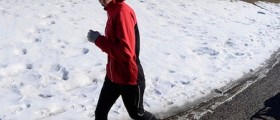
















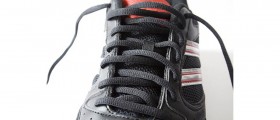

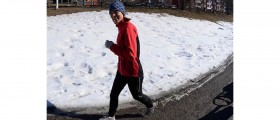
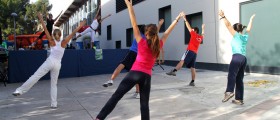

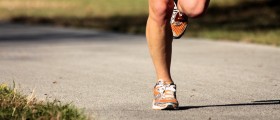


Your thoughts on this
Loading...